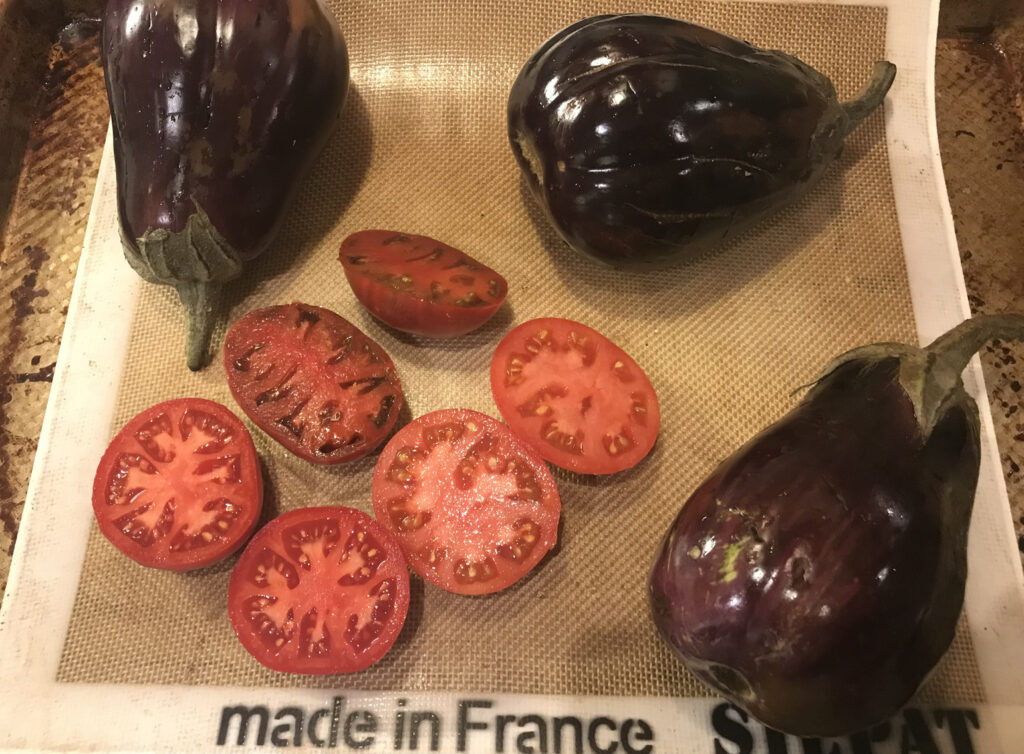
As I write this, it is mid-September, peak season for all things eggplant (what the Brits call ‘aubergine’) in Northern California. At my local farmers’ market, the varieties are many – from tiny, round, green Thai eggplant, slightly larger Fairy Tales, white and pale green chubbies (about which I know little), round Italian globes and elongated Japanese. It’s a wonderland of eggplant out there. Could I get my family to eat eggplant?
Less Than Excellent Eggplant
I didn’t grow up eating much eggplant. I remember my Mom putting slices into a dish of Parmesan once and hating it. I must’ve been six or seven years old at the time. (I don’t think she cooked it right.) I avoided it at restaurants, because why would I eat something unfamiliar? Oh, times have changed, indeed.
As an adult, I’ve managed to eat some less than excellent eggplant and some exceptional eggplant dishes. I still did not know, really, how to cook with it. I set out to change that, experimenting with eggplant dishes from a variety of the world’s cuisines and in many styles. I’m still not an expert but I have a much better sense of what I like and how to work with this not very fussy vegetable.
Committing to cooking eggplant does not have to be done at this time of year but, in general, when something is in season, it tastes much better. With a little coaxing and the right amount of cooking fat, eggplant is excellent.
Success or failure – both were guaranteed, right?
My Grand Eggplant–Aubergine Experiment
A.k.a. The Path to Excellent Eggplant
- Start simple and with what you know
Dish One: I kicked off my quest to get my family to like eggplant with a dish they’ve eaten many times before, Baba Ghanoush. There are plentiful recipes for this simple dish out there and you really can’t go wrong as long as you get the seeds out and char the eggplant until it is soft EVERYWHERE. I went with Kenji Lopez-Alt’s recipe, posted on Serious Eats.
Result: Easy-peasy, lemon squeezy. Everyone ate this dish. Bonus: it keeps in the fridge for days and can be used as a spread on sandwiches. I added a bit more tahini and lemon than Lopez-Alt.
Eggplant Variety: Purple Globe
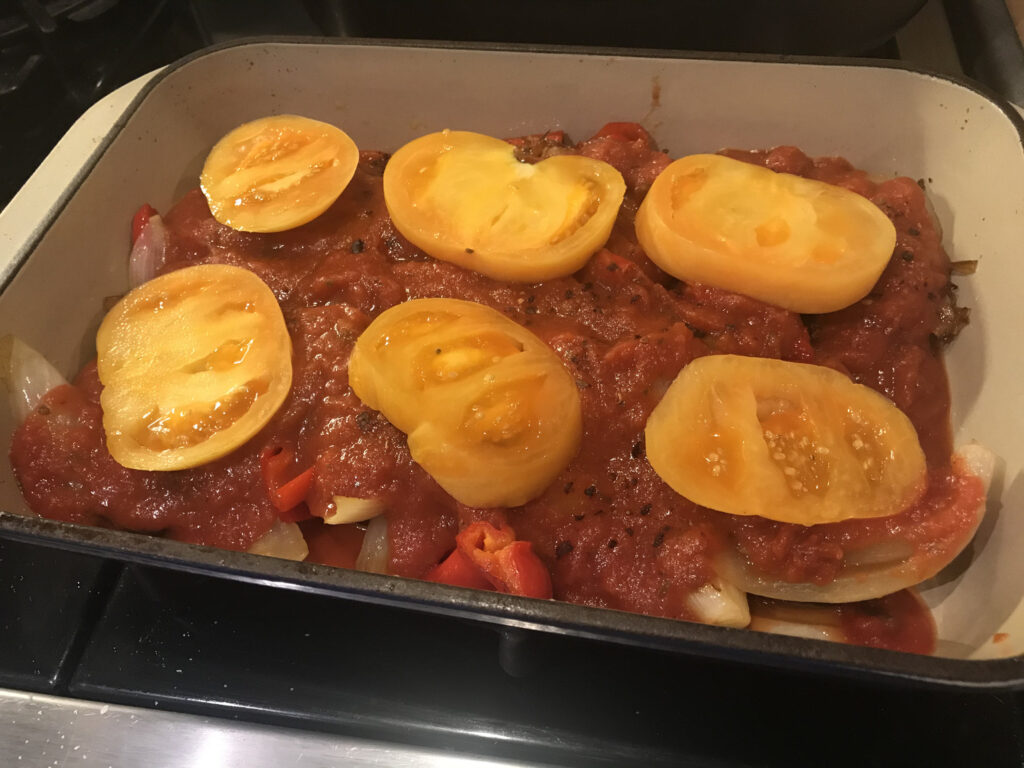
Dish Two: I chose a recipe from a blog that I was not familiar with – Oven-cooked eggplants and peppers in tomato sauce from a Greek-based recipe blogger, Aglaia Kremezi. The dish combined the best of summer produce with flavors familiar to my family.
Result: Another success, everyone ate this dish. I suspect it was because the eggplant is sliced thin and baked before it is combined with tomato, onion and peppers. It was well-disguised amidst the other deliciousness in the dish.
Eggplant Variety: Purple Globe
Dish Three: Crisp Eggplant Chips
Be prepared to reuse the frying oil as this recipe requires a pan filled with oil to fry thin slices of panko-crusted eggplant rounds. I made mine gluten-free with a breading mix I found at a Japanese supermarket in San Francisco.
Result: Home run – fried until crispy, eggplant went down the hatch without a blink. They are like eggplant potato chips, crispy when sliced think enough. I didn’t even need a dipping sauce. This dish is a bit tricky. Adding slices to boiling oil takes a bit of work for a home cook . I needed cheesecloth inside my coarse strainer to properly strain the oil and get out all of the crumbs.
Eggplant Variety: Japanese
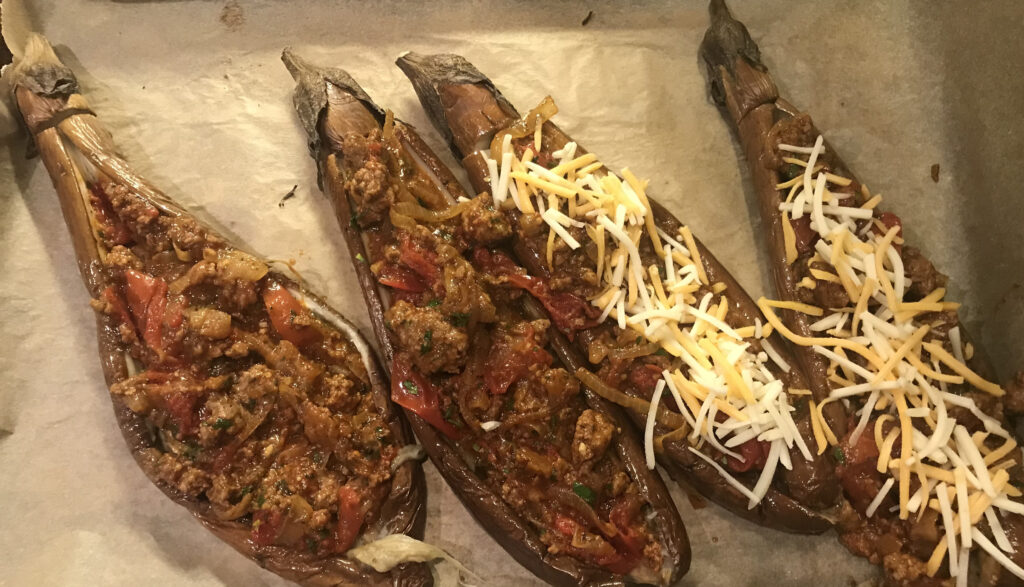
Dish Four: Eggplant and tomato was an initial success so I went for a repeat. I worked with a recipe from another chef I trust, Yotam Ottolenghi. This recipe, known as Imam Bayildi, first published by The Guardian in 2015, comes from the Turkish tradition.
Result: Mixed. I thought it was a delicious combination of flavors (cumin, oregano, garlic). But, there are plentiful, fussy steps, including soaking the eggplant (which felt counter-intuitive but works) and roasting it twice. The real issue, though, was it still looked like eggplant when I served it. One of my kids (not the risk-taker) would not touch it. The risk-taker took a bite and that was it.
Eggplant Variety: Purple Globe
- 2. Take Some Risks
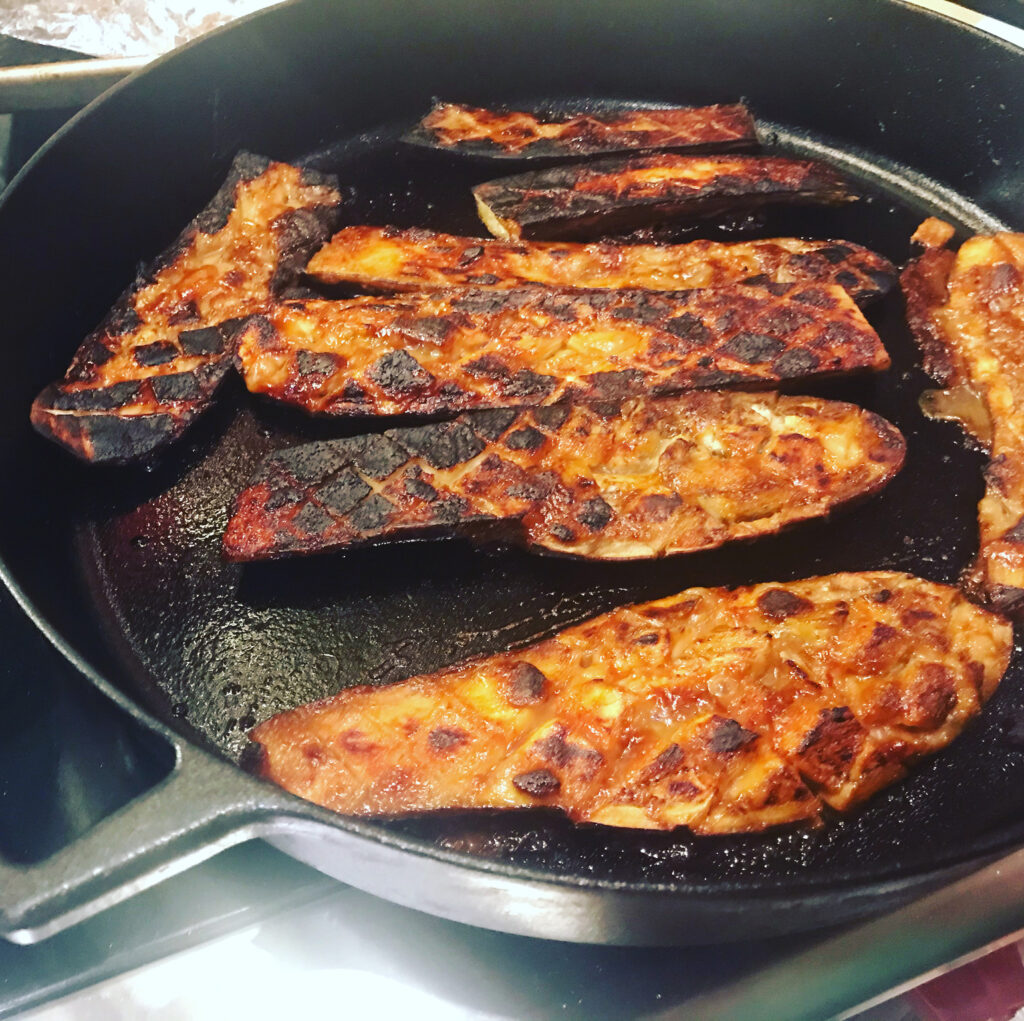
Dish Five: With mostly success so far, I ventured to Asia for the next series of dishes. I started with miso-glazed eggplant or nasu dengaku, recipe from Caroline Phelps’ blog. I’ve cooked plenty of Japanese dishes before and miso is a flavor everyone in my family was familiar with. This was the easiest dish of any I made, literally pan-frying the eggplant and then brushing the glaze over it.
Result: Another success. The miso glaze was delicious, and the preparation was so simple. No special gear or prep or peeling or anything. I used a cast iron pan which added a nice char to the eggplants.
Eggplant Variety: Japanese
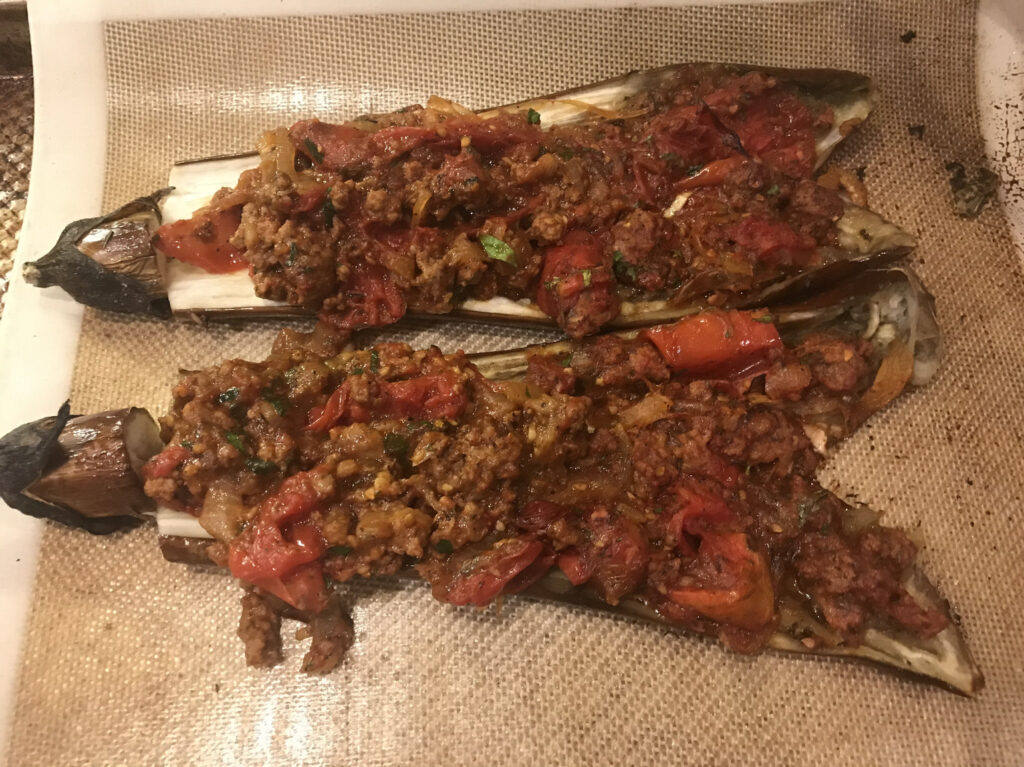
Dish Six: I went with a fussier recipe in a style that I thought would work for my family, Yunnan-style spicy pork-stuffed eggplants from Food & Wine magazine. I did not have black cardamom seeds on hand so I used the cardamom pods I had. I also left out the dried and fresh chiles, offering those on the side.
Result: Everyone loved the stir-fried pork but left behind the eggplant. Since this dish is a bit “cheffier,” there were plentiful steps. Seeing them not eat the eggplant was a bummer. I ended up eating their eggplants on toast for breakfast the next day.
Eggplant Variety: Japanese. I couldn’t find a seedless large eggplant as the recipe called for
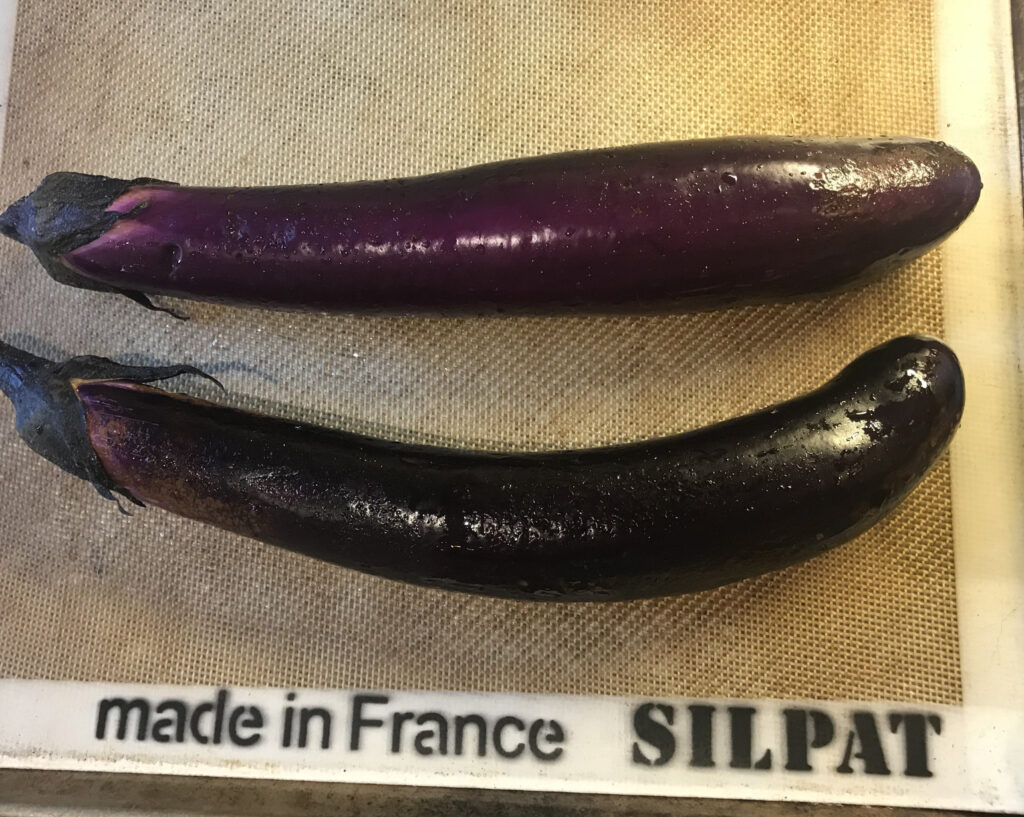
Dish Seven: Next up was Andrea Nguyen’s grilled eggplant with soy chao vinaigrette, a Vietnamese dish that called for fermented tofu. I left it out.
Result: Even without the fermented tofu, the dish was a winner. The charred eggplants are peeled and did not look like eggplant when served. The sweet-savory balance of flavors and “this doesn’t look like eggplant” worked for all eaters. The green onion oil is a nice touch but also not needed.
Eggplant Variety: Japanese. I found the darker purple variety worked better for peeling than its paler siblings.
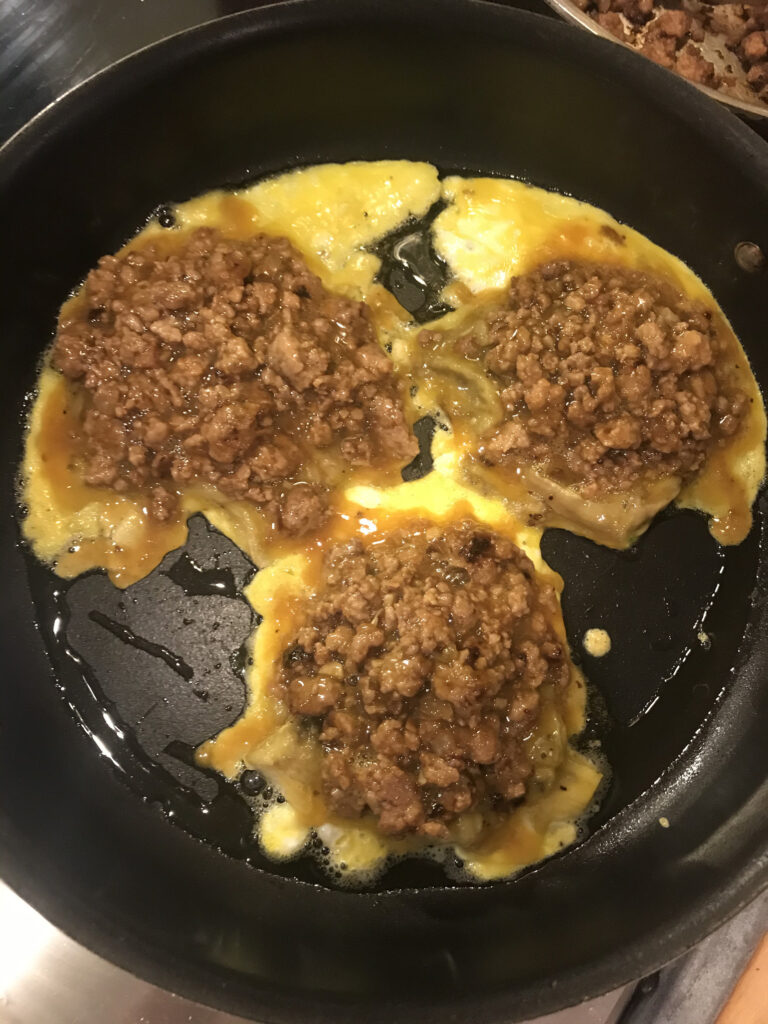
Dish Eight: Over to the Philippines for a Filipino eggplant omelet (tortang talong). I never considered making eggplant with eggs but it makes perfect sense – eggs go with just about everything.
Result: Two in my family wouldn’t touch it. My risk taker tried it and did not like the texture, eating around the eggplant to just eat the eggs. I thought it was ok but suspect I did not chop the eggplant finely enough to hide it inside the batter.
Dish Nine: India was the last stop on my eggplant tour. (I did not come across any eggplant dishes from Africa or South America. Perhaps there is no tradition of eggplant in these regions?) The famous baingan bharta, or roasted eggplant mash, is a dish I’ve enjoyed at Indian restaurants. The combination of eggplant, garlic and tomato was also promising of success.
Result: Another winner. Everyone ate this dish and it was a great spread for my morning toast the next day.
Tips for Excellent Eggplant
- If the recipe calls for charred eggplant that needs to be seeded, I recommend grilling or broiling it the day before you plan to use it. Otherwise, prep time evaporates before the damn things are cool enough to handle.
- Char eggplants until the entire thing is soft. No one wants to eat hard pieces of eggplant.
- Seeding eggplants is a pain. Not every eggplant has easy to remove seed sacks. Choose wisely, young Skywalker, and save yourself a ton of time.
- You don’t always have to remove seeds from Globe eggplants but the final result will be smoother and taste better. Even if a recipe does not call for seeding, if you are using Globe or other seeded eggplants, do this!
- “Hidden” eggplant dishes, where the eggplant is sliced thin and layered with other veggies, pureed to a pulp, or otherwise disguised were more successful than “in plain sight” eggplant. The notable exception to this rule was the miso-glazed eggplant.
- Old eggplants taste bitter. Always. Use them as soon as you purchase them, ideally from a farmers’ market.


